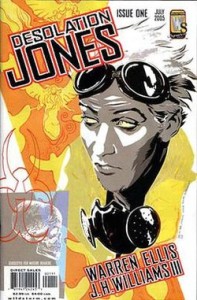 The long shadow of John Constantine lingers over the figure of Desolation Jones. But whereas Constantine is a spiky-haired Brit occult operative who abuses his odd network of friends while intimidating people into giving him answers by sheer force of personality, Jones is a spiky-haired Brit ex-spook who abuses his odd network of friends while intimidating people into giving him answers by sheer force of personality.
The long shadow of John Constantine lingers over the figure of Desolation Jones. But whereas Constantine is a spiky-haired Brit occult operative who abuses his odd network of friends while intimidating people into giving him answers by sheer force of personality, Jones is a spiky-haired Brit ex-spook who abuses his odd network of friends while intimidating people into giving him answers by sheer force of personality.
Also, Constantine wears a brown trench coat and smokes. Jones wears an orange trench coat and goggles, and does a lot of drugs.
The setup for Desolation Jones, by iconoclastic comics writer Warren Ellis, is a fun one. What if all of the intelligence agencies in the world agreed to use Los Angeles as the dumping ground for their ex-agents, failed experiments, and people who needed to disappear? Kept within the city’s borders — because let’s face it, who’s going to notice a few more oddballs in LA — the agents have formed a parasitic subculture of fixers, investigators, porn magnates and other lowlives as they live out the string. And at the far end of even this web of the unlovely and unloved is Desolation Jones, former British agent and sole survivor of the infamous Desolation Test. The test, it seems, involves hopping the target up on stimulants and force-feeding him a steady stream of horrific imagery. What this is intended to accomplish is left unclear, but Jones is the only survivor, and now he works the fringes of the ex-spook scene as a private investigator.
Trouble comes Jones’ way in the form of an elderly client who is being blackmailed over a missing item from his personal pornography collection — Adolph Hitler’s personal amateur skin flick. Needless to say, there’s more to this case than meets the eye, and as Jones dives deeper into the investigation, we both meet his extended network of contacts and unravel the layers of the mystery. It’s all very post-modern Hammett, with the dying rich old man’s daughters maneuvering around one another, oddball informants and double-crosses, and humble servants who are more than meets the eye.
Of course, with this being Warren Ellis, there’s also a heaping handful of lengthy, tangentially related exposition. This includes a seven-page walk through the realities of the pornographic movie industry that, while educational, feels more like an auctorial hobby horse than a germane plot point.
That’s where J. H. Williams III’s artwork really comes to the rescue. The book is done in a variety of styles, changing up page to page and often panel to panel. This, more than the dialogue, gives us a window into Jones’ fault-line-ridden mind and perceptions, and gives Jones much of the personality he possesses.
With an iteresting lead character, a quirky supporting cast and an intriguing setting, Desolation Jones has a lot going for it. It’s not enough to make the reader forget entirely about the painfully strong Constantine parallels, or gloss over some of the sketchier plot points (Why is this drug-addled near-invalid suddenly able to whup all sorts of ass all over Los Angeles when the mood takes him? Why does anyone even talk to this guy?), but enough to make Desolation Jones an interesting read, and to hold out promise for better things to come.
(Wildstorm, 2007)
